|
Shanghai International Shipping Institute published
the Chinese Shipping Prosperity Report in Q1 2016 on April 5, 2016. The report
shows that the Chinese Shipping Prosperity Index (CSPI) stood at 77.96 points
in the stagnant interval in Q1 2016, a new low since the first publication of
Chinese shipping prosperity index in 2009. The Chinese Shipping Confidence
Index (CSFI) registered 49.42 points, remaining in the depression since Q3
2011. The overall business performance of ship owners, port enterprises and
shipping service enterprises kept deteriorating.
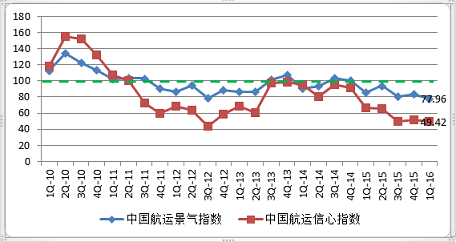
Fig.
1 Trends of Chinese Shipping Prosperity Index and Confidence Index
1 Profitability of Ship Owners Continues Deterioration But with Enhanced
Control over Shipping Capacity
In Q1 2016, the prosperity index of shipping
transport enterprises stood at 77.94 points in the stagnant interval; the
confidence index of shipping transport enterprises stood at 29.29 points in the
moderately stagnant interval. Affected by the dramatically declining space utilization
and freights, the profitability of ship owners continued to deteriorate. Ship
owners strengthened control over the shipping capacity and their willingness in
shipping capacity investment hit a historic bottom. When the global seaborne
transportation market fails to see improvement in the short term, ship owners significantly
enhanced the control over the current funds.
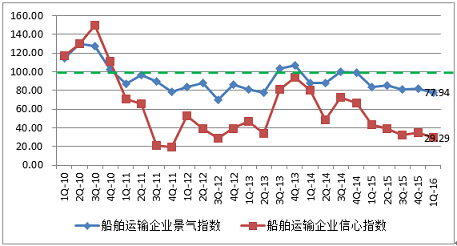
Fig
2 Trends of Prosperity Index and Confidence Index of Shipping Transport
Enterprises
Capital chains of seaborne dry bulk transportation enterprises tightened. In Q1 2016, the prosperity index of dry bulk
transportation enterprises was 62.28 points in the stagnant interval, down 6.39
points from the previous quarter; the confidence index of dry bulk
transportation enterprises was 7.22 points, down 33.34 points from the previous
quarter and falling to the moderately stagnant interval. The vessel turnover of
dry bulk transportation enterprises dropped dramatically and the freights kept
hitting new lows, leading to sprawling losses of enterprises. The prosperity
index of profit/loss indicator of dry bulk transportation enterprises was only
25.33 points. As a result, nearly half of dry bulk transportation enterprises
suffer financial constraints and this proportion is 11.4 percentage points
higher than that in the previous quarter.
Fig.
3 Prosperity Index of Business Indicators of Dry Bulk Transportation
Enterprises
Profitability of container transportation enterprises deteriorates
dramatically. In Q1 2016, the current funds, enterprise financing
and labor demand indicators of container transportation enterprises all enjoyed
slight pickup and stayed in the prosperous interval. However, the prosperity
index of enterprise profitability only registered 59.95 points, mire in the stagnant
interval for four consecutive quarters. The profitability of container
transportation enterprises witnessed sharp deterioration. In addition, affected
by the increased loan liability, lowered freights and increased operating
costs, the enterprises are increasingly reluctant in shipping capacity
investment.
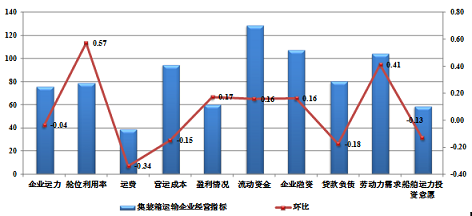
Fig. 4 Prosperity Index of Business Indicators of Container Transportation Enterprises
2 Inflection Point of China’s Port Industry in Sight
After the financial crisis, the seaborne transportation
market becomes dismal and bankruptcies of shipbuilding enterprises or shipping
enterprises frequented the headlines. Against the backdrop, however, China’s
port enterprises maintained a stable development trend. But with the continuous
slowdown of China’s economy growth, the business volume of port enterprises
kept gliding and the profitability performance of loading/unloading businesses
of port enterprises is nowhere near the past. In Q1 2016, the prosperity index
of Chinese port enterprises registered 79.04 points in the stagnant interval, a
historic low. Affected by the slowed-down growth of China’s economy, the port
throughput, berth utilization, port charges all witnessed sharp declines
against Q4 2015, with the profitability of port enterprises deteriorating
severely. In Q1 2016, the prosperity index of port enterprise profitability was
51.89 points, refreshing the historic low and staying in the stagnant interval.
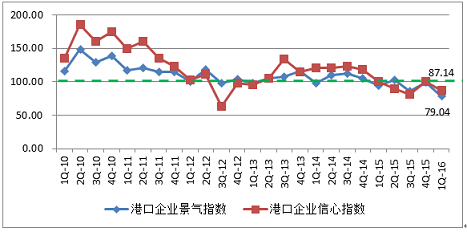
Fig.
5 Trends of Prosperity Index and Confidence Index of Chinese Port Enterprises
3 Shipping Service Enterprises Stagnant for 4.5 Years in a Row
According to Chinese shipping prosperity survey,
the prosperity index of shipping service enterprises in Q1 2016 stood at 76.91
points, a rise of 13.41 points from the previous quarter but still in the
stagnant interval. In Q1 2016, the confidence index of shipping service enterprises
was 38.53 points, a slight pickup from the historic low in the previous
quarter, but still in the moderately stagnant interval. The market was haunted
by the pessimistic attitude. In terms of business indicators, apart from the current
funds which is relatively assuring, all the other indicators such as the
business volume, the business orders, profitability and labor demand were in
the stagnant interval, showing the deteriorating business performance of
enterprises.
Fig. 6 Trends of Prosperity Index and
Confidence Index of Chinese Shipping Service Enterprises
4 Forecast of Q2 2016
Q2 2016, it is forecast that the CSPI will reach 97.18 points, 19.22 points higher than the previous quarter to return to the slightly stagnant interval. The CSFI is forecast at 60.78 points in the stagnant interval. According to Chinese shipping prosperity survey, 55.2% of surveyed shipping enterprises hold a pessimistic view toward the overall performance of shipping industry in Q2.
Fig.
7 Forecast Trends of CSPI and CSFI
Deterioration of shipping transport enterprises
expected to ease. According to Chinese shipping prosperity survey,
the prosperity index of shipping transport enterprises in Q2 2016 is forecast
at 97.73 points, approaching the demarcation line. The confidence index of
shipping transport enterprises in Q2 2016 is forecast at 42.86 points, up 13.57
points compared with Q1 but still in the moderately stagnant interval,
reflecting enterprise owners’ lack of confidence in the industry. In terms of
the business indicators, persons in charge of ship owners generally hold a high
expectation of growth in the freights and vessel turnover in Q2, and the
profitability and current funds indicators will also improve. To be specific,
the prosperity index of container transportation enterprises is forecast at
105.4 points and may step into the prosperous interval again after one year of
depression. The prosperity index of dry bulk transportation enterprises is
forecast at 88.99 points, 26.71 points higher than the previous quarter and in
the relatively stagnant interval.
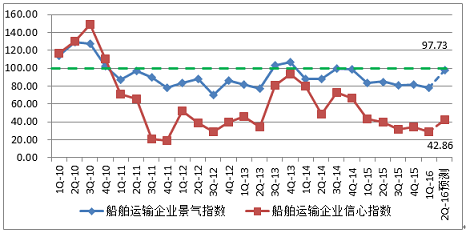
Fig.
8 Forecast Trends of Prosperity Index and Confidence Index of Shipping
Transport Enterprises
The prosperity index of port enterprises gaining on
the demarcation line. According to Chinese shipping prosperity survey,
the prosperity index of port enterprises in Q2 2016 is forecast at 99.27
points, an increase of 20.23 points from the previous quarter, gaining on the
demarcation line but still in the slightly stagnant interval. The confidence
index of port enterprises is forecast at 84.87 points in the stagnant interval.
The throughput, berth utilization and other business indicators of port
enterprises will all welcome significant growth, but as the port charges may
decline and operative costs may go up, the profitability of port enterprises
may have limited space for improvement in Q2.
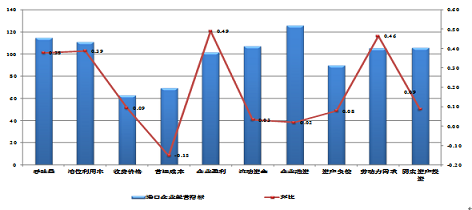
Fig. 9
Forecast of Business Indicators of Port Enterprises in Q2 2016
Deterioration in business performance of shipping
service enterprises may slow down. According to Chinese shipping prosperity survey,
the prosperity index of shipping service enterprises in Q2 2016 is forecast at
94.34 points, an increase of 17.43 points from the previous quarter, but still
in the slightly stagnant interval. The confidence index of shipping service
enterprises in Q2 2016 is forecast at 60.57 points in the stagnant interval.
The business orders and profitability indicators of shipping service
enterprises will enjoy improvement.
Fig. 10 Forecast Trends of Prosperity Index and Confidence Index of
Shipping Service Enterprises
5 Ship Owners Plan
Multiple Measures for ECAs
The Yangtze River Delta will take the lead to implement emission reduction
since April 1, 2016. The Pearl River Delta and Bohai Rim Waters will keep up
soon. How will shipping enterprises cope with the Emission Control Area plan?
What new opportunities are there? Shanghai International Shipping Institute
conducted a survey on ship companies. The survey shows that more than 60% of surveyed
ship owners chose “Replace the commonly used heavy oil with more expensive
low-sulphur fuel”, 37.5% of surveyed ship owners chose "Use technically
feasible emission cleaning or control equipment", 5% of ship owners chose
"Consider to use LNG as the fuel" and 10% of the surveyed ship owners
chose "Avoid entry into ports within the ECAs".
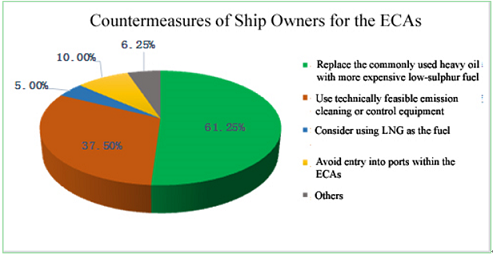
Fig. 11 Ship Owners' Countermeasures to ECAs
Note: Questions in this survey allow multiple
choices.
6 Seaborne Transportation Enterprises Call for Financial and Tax Policy
Support from Government
With the excessive seaborne shipping capacity worldwide and the low
freights for a long time, the business performance of enterprises is on the
slide and the seaborne transportation industry calls for government support.
The most requested support from enterprises is about the financial and tax
support from the government. Around 38.75% of ship owners chose "national
financial and tax policies and support to ease business operation
pressures" and around 20% of shipping owners chose "support from
alliances that share a united front". Some other enterprises chose
"support from cargo owners with stable cargo sources" or
"support from financial organizations who can offer capitals".
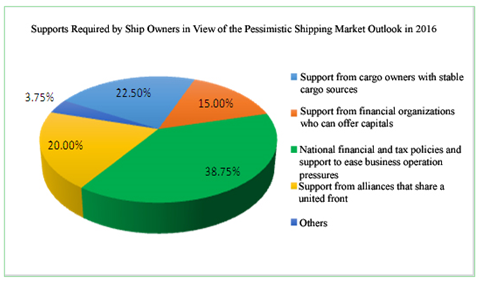
Fig. 12 Survey Results of Supports Required by Ship
Owners in View of the Pessimistic Shipping Market Outlook in 2016
|